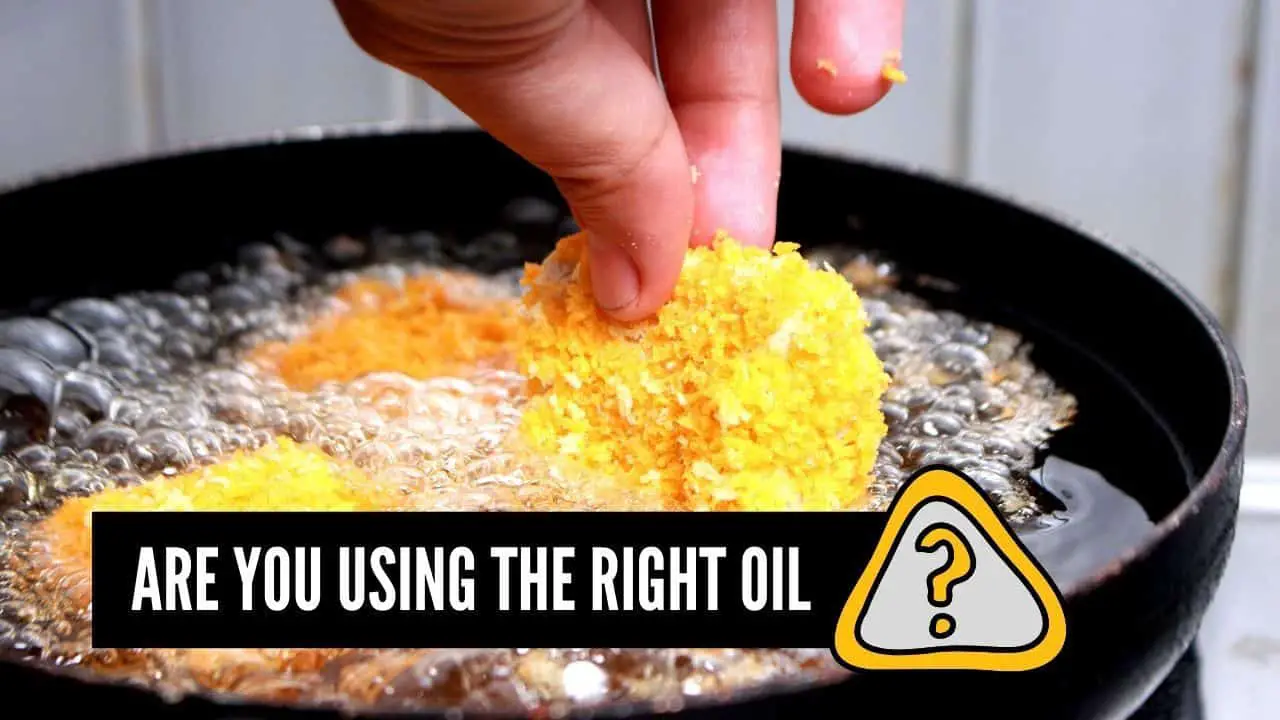Master the science and art of deep-frying at home with these handy tips and tricks. Using the right oil, correct temperature, and cooking time will give you a perfectly golden and crunchy sweet or savory dish every time.
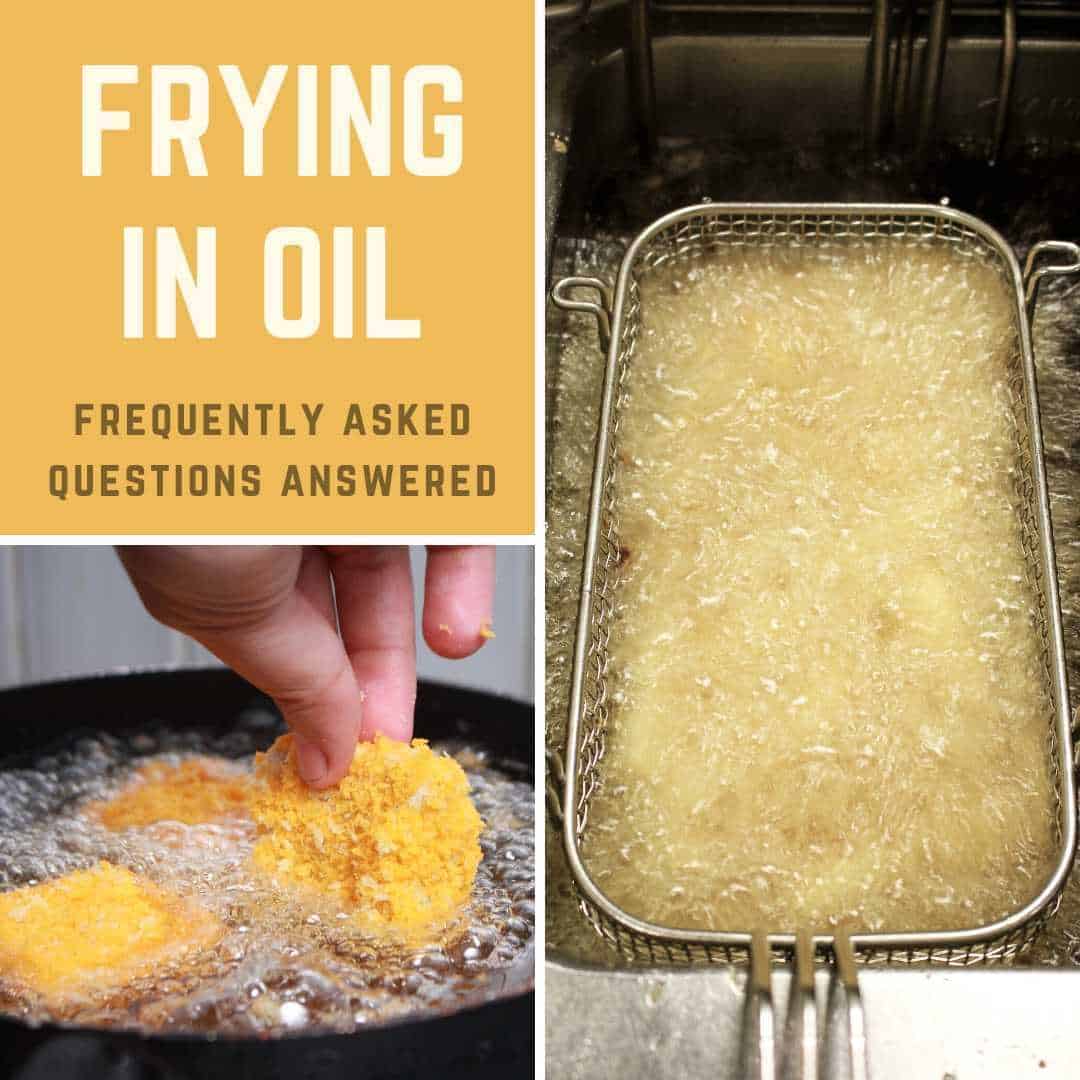
Deep-frying food is a popular cooking method that is widely used around the world by food industries, restaurants, and kitchens at homes.
Even though it’s so popular, there are many questions about the best deep-frying technique. In this article, I will try to answer everything you need to know about deep-frying to help you really master this cooking method.
What Is Deep-Frying?
It is a cooking method when food is submerged and cooked in hot oil till you get a crunchy golden brown surface and tender interior. It sounds simple, but actually, there are a few things that you should know to get the best and most delicious results.
Deep-Frying 101

Below are all the steps for successful deep frying food at home. I will break down each one further down in the article.
- Use the appropriate oil.
- Use enough oil so that you can submerge the food entirely in it.
- Heat it to the required temperature.
- Test it with one piece of food.
- Place the food carefully in the pot. (Use a kitchen spider or pair of long tongs to be safe) If using the fryer, then use the wire basket.
- Cook it till golden brown. (Flip the food over if needed).
- Remove the food from the oil and place it on the kitchen towel to soak in excess fat.
- Put in the next patch of food or remove the oil from the heat and let it cool down.
- Eat your food and share it with friends and family.
- Once the oil is cooled down, clean it, and store it.
IMPORTANT things to remember:
- Be careful. The oil is super hot.
- Never leave a deep fryer unattended.
- Keep the temperature steady throughout the cooking.
- Do not overfill the fryer pot or basket with food. That will lower the temperature, and your food will turn out greasy.
- Do not pour too much oil into the pot or the container. Oil expands when it gets hot, and you don’t want it to spill over and catch fire. Fill the pot no more than half full.
- If you are heating the pot over a gas flame, make sure that the flames do not extend further than the pot’s width, as hot oil can easily catch fire.
- Make sure your food is dry, and keep the water away from hot oil.
- Keep the oil clean from pieces of leftover food; you don’t want anything floating in it.
What’s The Right Temperature For Deep-Frying?
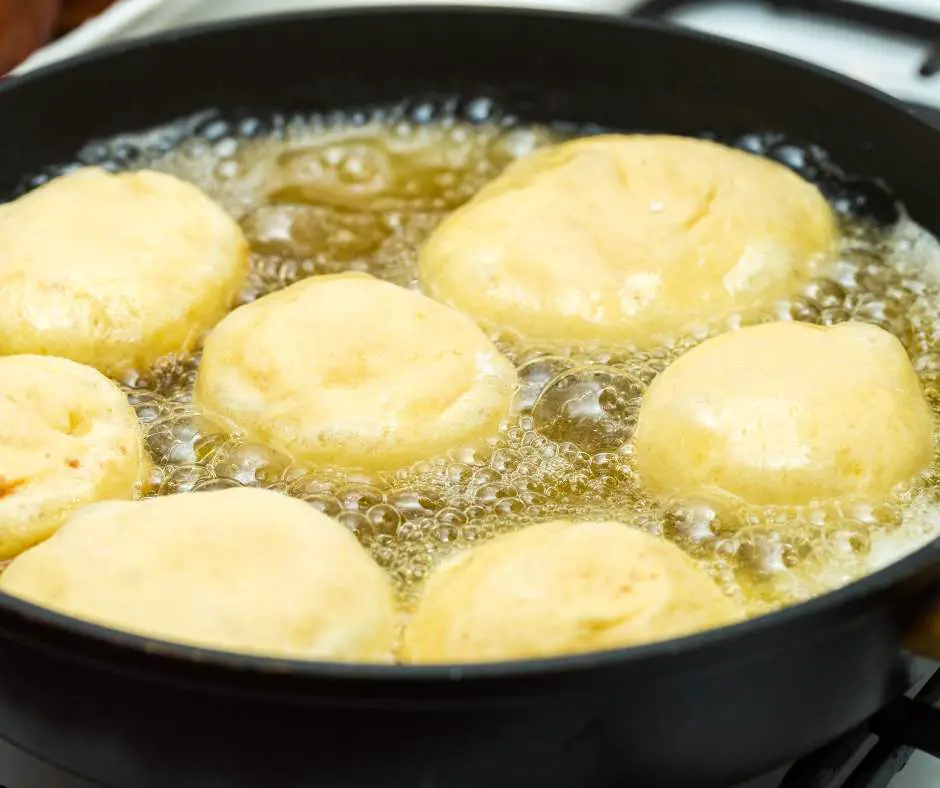
Depending on the food, the optimal deep-frying temperature is between 350°F – 375°F (176 to 190°C). For french fries, it is 375°F (190°C); for chicken nuggets and fish, 365°F (185°C). If the temperature is too low, food will absorb too much grease; if too high, food will burn.
Frying at the right temperature is one of the most important elements for successful deep-frying. Yes, it is done at high temperatures, and the oil needs to be hot hot hot, but not too hot.
Some people tend to believe that the higher the temperature, the better the frying process. But this is not actually true; too high a temperature will make the frying oil degrade much. Also, food will burn on the outside before cooking on the inside.
On the other hand, you shouldn’t fry your food at a too low temperature either; then, the food will absorb too much fat and become greasy.
Look at the table below for more details.
The best way to make sure that the temperature is right and keep the oil temperature steady is to use a cooking thermometer. I use this cheap and simple thermometer like the one below, and it works great and will last for years.
TAP ON IMAGE TO VIEW PRICE
How To Check The Temperature Without The Thermometer?
If you don’t have a thermometer available in your kitchen, that doesn’t mean your frying can’t come out perfectly. A useful tip is to take one piece of food or breading, put it in the oil, and see if it fries. Make sure it is cooked inside and nice and golden outside. If it is, then your oil is ready. If not, wait a few more minutes and test again.
Never put water into the hot oil because that will make it splatter, and it may burn you.
Check Out These 6 Proven Methods: How To Tell If Oil Is Hot Enough To Fry?
Recommended Deep Frying Temperature And Cooking Times
| Deep Fried Food | Oil Temperature | Average Cooking Times |
|---|---|---|
| The Ramnut | 325°F (160°C) | 2 or 3 minutes |
| Fried chicken wings | 350°F (170°C) | 8 to 10 minutes |
| Fried Potato Chips | 375°F (190°C) | 1 1/2 minutes |
| Battered Fish sticks | 375°F (190°C) | 6 to 8 minutes |
| French Fries | 350°F (177°C) | 5 to 6 minutes |
| Churro Sticks | 360°F (183°C) | 4 to 6 minutes |
| Donuts | 375°F (190°C) | 2 to 4 minutes |
| Fried Onion Rings | 365°F (185°C) | 2 to 3 minutes |
| Fried Calamari | 375°F (190°C) | 1 to 3 minutes |
| Fried Mozzarella Sticks | 365°F (185°C) | 30 seconds to 1 minute |
| Battered Shrimp Tempura | 350°F (170°C) | 2 to 3 minutes |
| Ham and Cheese Croquettes | 350°F (170°C) | 6 to 8 minutes |
| Fried Mac and Cheese Balls | 375°F (190°C) | 3 to 4 minutes |
| Fried Pork Chops | 375°F (190°C) | 5 to 6 minutes |
| Chicken Fried Steak | 325°F (163°C) | 6 to 10 minutes |
| Fried Chicken Tenders | 375°F (190°C) | 6 to 8 minutes |
| Apple Fritters | 375°F (190°C) | 3 to 4 minutes |
| Deep Fried Oreo Cookies | 375°F (190°C) | 2 to 4 minutes |
| Fried Cheese Curds | 375°F (190°C) | 4 to 6 minutes |
| Funnel Cakes | 375°F (190°C) | 4 to 5 minutes |
| Beef or Chicken Chimichanga | 375°F (190°C) | 3 to 4 minutes |
| Southern Fried Okra | 375°F (190°C) | 3 to 5 minutes |
| Corn Dogs | 375°F (190°C) | 2 to 3 minutes |
| Corn Fritters | 375°F (190°C) | 4 to 6 minutes |
| Crispy Fried Spring Rolls | 375°F (190°C) | 6 to 8 minutes |
| Powdered Sugar Coated Beignets | 375°F (190°C) | 2 to 3 minutes |
| Fried Jalapeno Poppers | 375°F (190°C) | 3 to 4 minutes |
| Chicken Nuggets | 350°F (170°C) | 2 to 3 minutes |
| Fried Ice Cream Balls | 365°F (185°C) | 10 to 15 seconds |
| Fried Cauliflower Wings | 320°F (160°C) | 3 to 4 minutes |
| Fried Mars Bars | 350°F (170°C) | 30 seconds to 1 minute |
| Fried Pickles | 375°F (190°C) | 2 to 3 minutes |
| Fried Banana Fritters | 365°F (185°C) | 4 to 5 minutes |
| Deep Fried Blooming Onion | 375°F (190°C) | 2 to 4 minutes |
| Churros | 400°F (204°C) | 4 to 5 minutes |
| Deep Fried Whole Turkey | 325°F (162°C) | 3 1/2 minutes per pound |
| Deep Fried French Toast | 375°F (190°C) | 1 to 2 minutes |
| Deep Fried Cinnamon Rolls | 350°F (170°C) | 2 to 3 minutes |
| Crispy Deep Fried Bacon | 375°F (190°C) | 3 to 4 minutes |
| Deep Fried Sauerkraut Balls | 375°F (190°C) | 3 to 4 minutes |
Note: When double frying French fries, the oil temperature will vary between the first and second fry.
What Oil Is The Best For Deep-Frying?
An adequate smoke point is the main thing to look for when choosing an oil for deep frying. Different cooking oils react differently to high heat, and when they get really hot, they begin to break down and eventually start to smoke and give burnt flavor to your food; that point is called ‘the smoke point.‘
That means that some oils are more suitable for deep frying than others.
So, choosing one with quite a high smoking point is important. Oils with lower smoking points, like extra virgin olive oil or butter, are better for cooking and sautéing.

In general, in everyday cooking, there are many good options to choose from. Oils such as sunflower, soybean, peanut, corn, canola, cottonseed, palm, palm kernel, and coconut are all good options.
You could even use extra virgin oil, but make sure the temperature stays below 320°F (160°C), so it won’t be suitable for most deep-fried dishes that require a higher temperature to cook them properly. (Please see the complete list below).
Other things you should also consider are the taste and the price and whether or not the cooking oil is healthy. How healthy it comes down to the ratio of polyunsaturated fats (good fats) and saturated fats (bad cholesterol). So, always check the label.
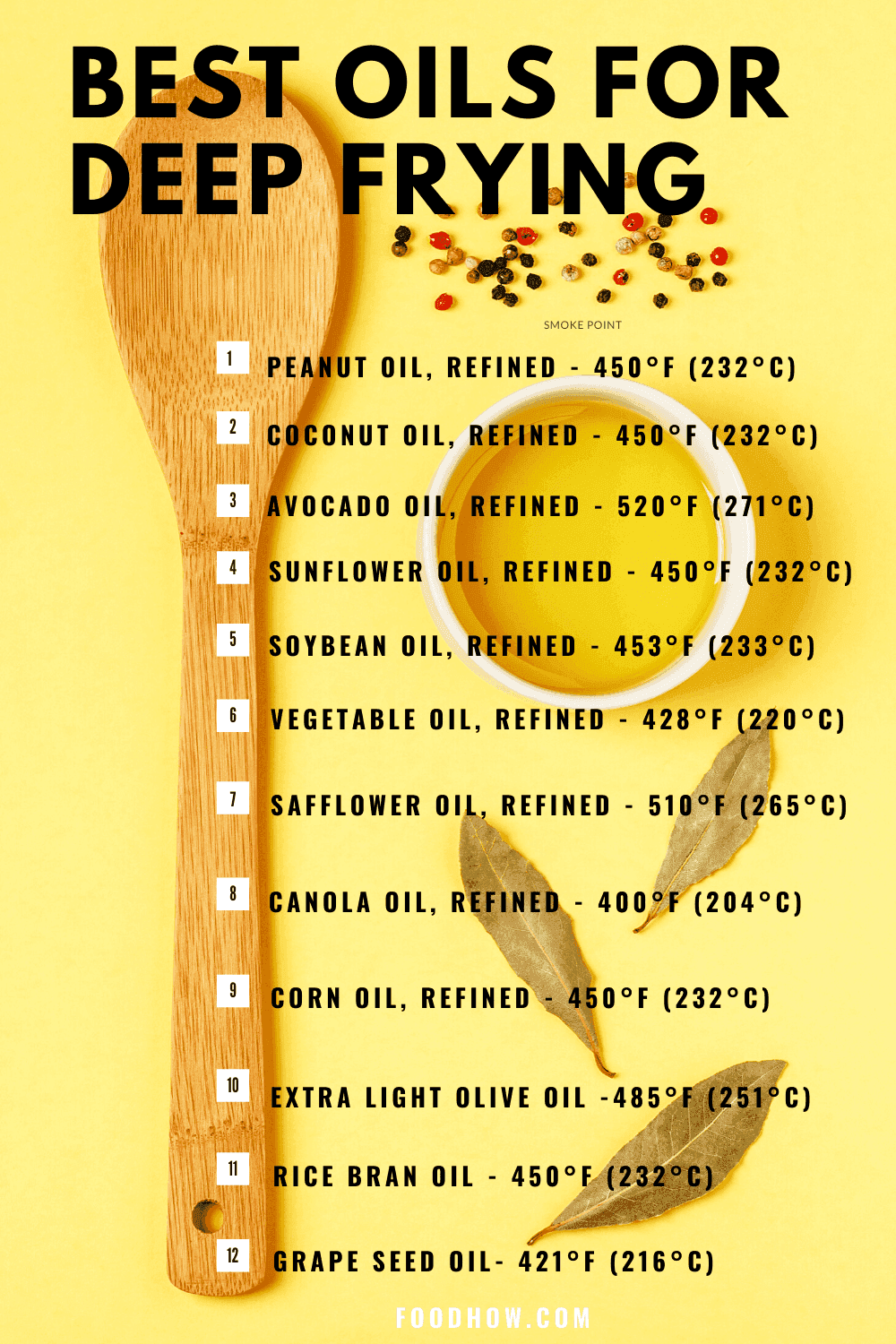
Can You Mix Different Types Of Oil?
Yes, you can mix different oils for frying, but it is not recommended. Each type has different properties, smoke points, tastes, and aromas.
But let’s say that you run out of one particular oil before you finish cooking. Your best solution is the combine the ones with a similar flavor and smoking point. For example, coconut oil has a very particular strong flavor, and it doesn’t go well with sunflower oil, which is more neutral.
Can I Fry Different Types Of Food In The Same Oil?
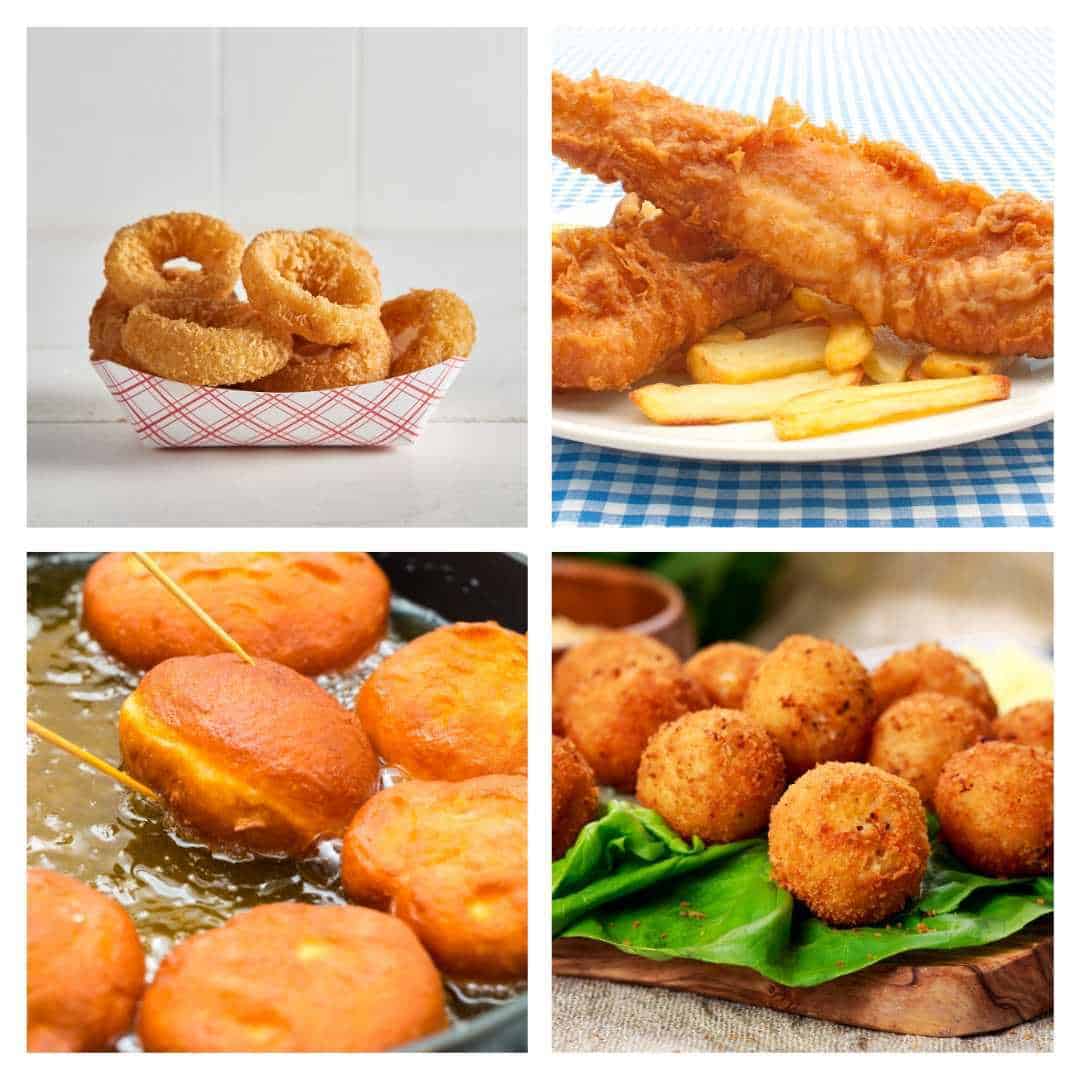
Avoid frying different foods in the same oil. Foods such as fish and onions can pass on a strange flavor to other foods. However, if you don’t mind having your doughnuts taste a bit like fish, then go right ahead.
Also, certain foods give a dark color to the frying oil. For example, frying scallops or breaded food will make the oil dark. So, if you cook fries in the same oil, they will be much darker and may not look that appealing.
Avoid Salting Your Foods Before Deep-Frying
If you put salt on your food before frying it, the salt will combine with water and fat and change the intended flavor of the food. Also, the salt will make the oil go bad much faster. Better avoid salt as much as possible when frying. Just add it to your food afterward.
How Do I Prevent Hot Oil From Popping?
When cooking at such high temperatures, hot oil will pop and splatter. It is inevitable. But if you follow the tips below, you can minimize the effect and protect yourself from burns.
- Avoid water. When coming into contact with very hot oil, water vaporizes instantly and turns into super-strong steam. The steam expands quickly, causing oil bubbles to splatter, and they might burn you.
- Ensure that your pot or fryer is totally dry before starting the frying process. Wipe it dry or simply heat the empty pot for a few minutes before pouring in the oil so that all moisture will evaporate.
- Make sure that the food you are about to fry is not wet, which can happen if it has been frozen. If the food is retaining moisture, pat it with a paper towel. If the food is still frozen, then remove the excess ice. That will prevent the oil from popping and splattering. If you fry battered foods, remove excess batter.
- Never fill the cooking pot or fryer all the way to the top. You should allow some space for the oil to rise when you add the food.
- Do not overcrowd the pot with food; leave some space. The oil will pop, and your food might not be evenly cooked.
- Don’t “throw” the food in the hot oil; place it slowly and gently. A tong is usually a good kitchen tool to use. Protect your body against hot oil splatter by wearing long sleeves, long pants, and an apron while frying.
Can I Reuse Frying Oil?
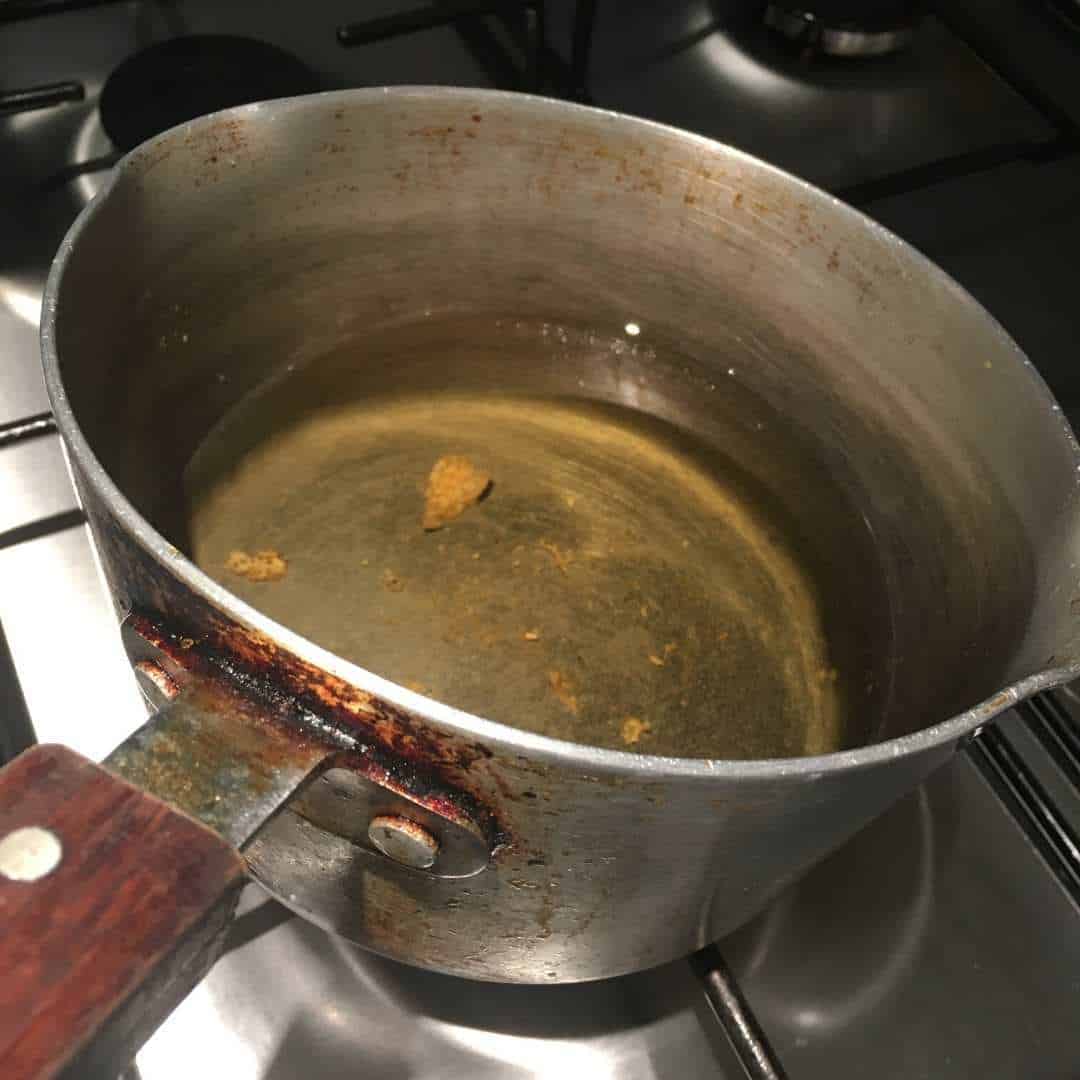
Yes, you can reuse frying oil. There is no definite rule regarding how many times you can reuse the oil. The quality of frying oil deteriorates the more you use it, but you can keep reusing it until you start seeing some signs that it is time to change it. (Check out the signs below)
How Do I Know If The Oil Has Gone Bad?
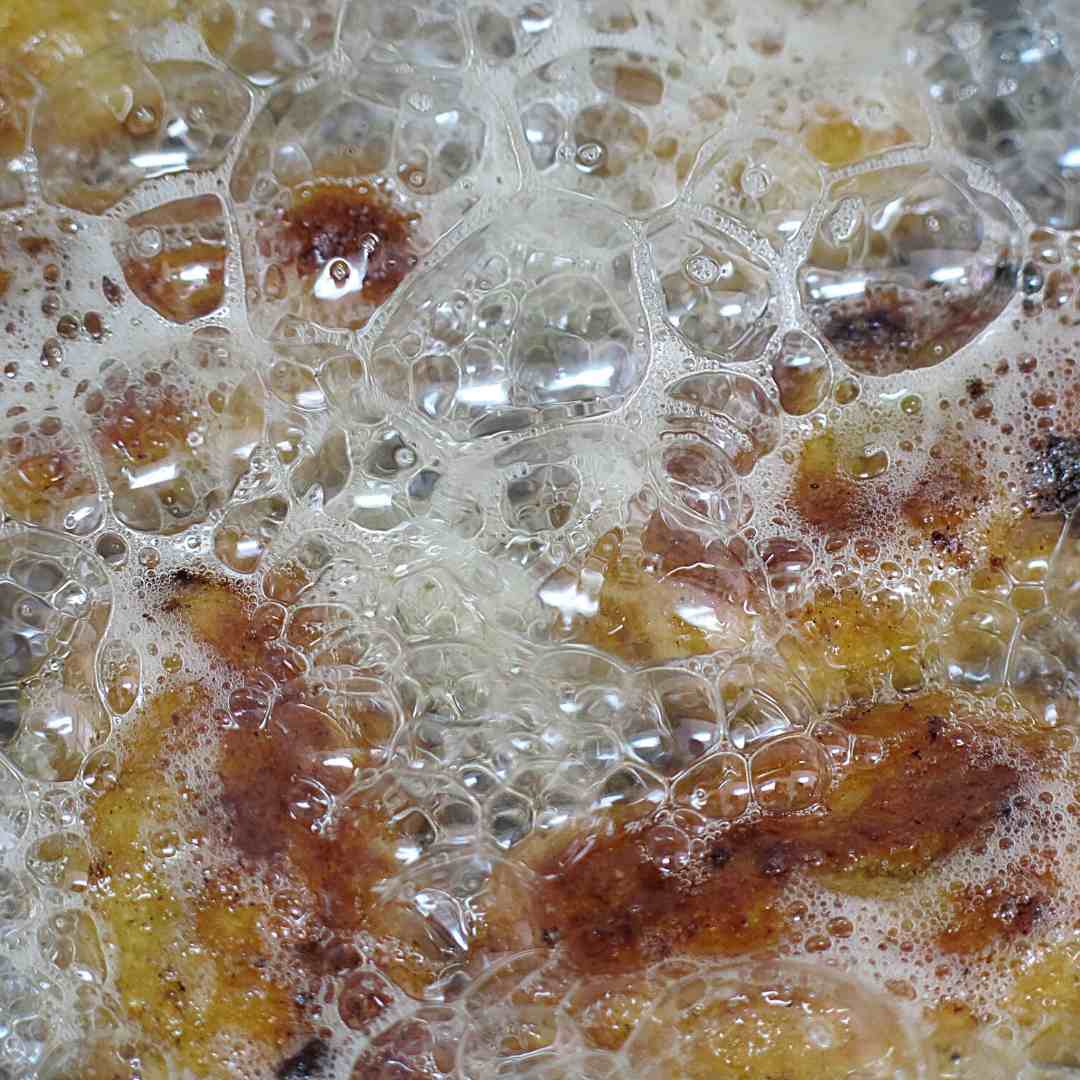
Foaming is caused by oil contamination or degradation because of overusing the oil or too high a temperature or low-quality oil.
Here are a few signs that you should know if it’s time to discard your frying oil. If you notice any of the things below, then it’s time to change your oil.
- Oil is becoming too tick.
- It is getting too dark.
- It has developed a persistent foam layer.
- Your food is turning out too greasy.
- It starts to smoke easily.
- Your food has a bitter taste.
- There is a strong, unusual odor or a smell of grease.
Whatever the taste or color, I recommend you change the frying oil after six months of use. For high-volume restaurants, you probably need to change it every week, but for cooking at home, perhaps change the oil after every six to eight times you use it.
Deep-Frying In A Pot At Home
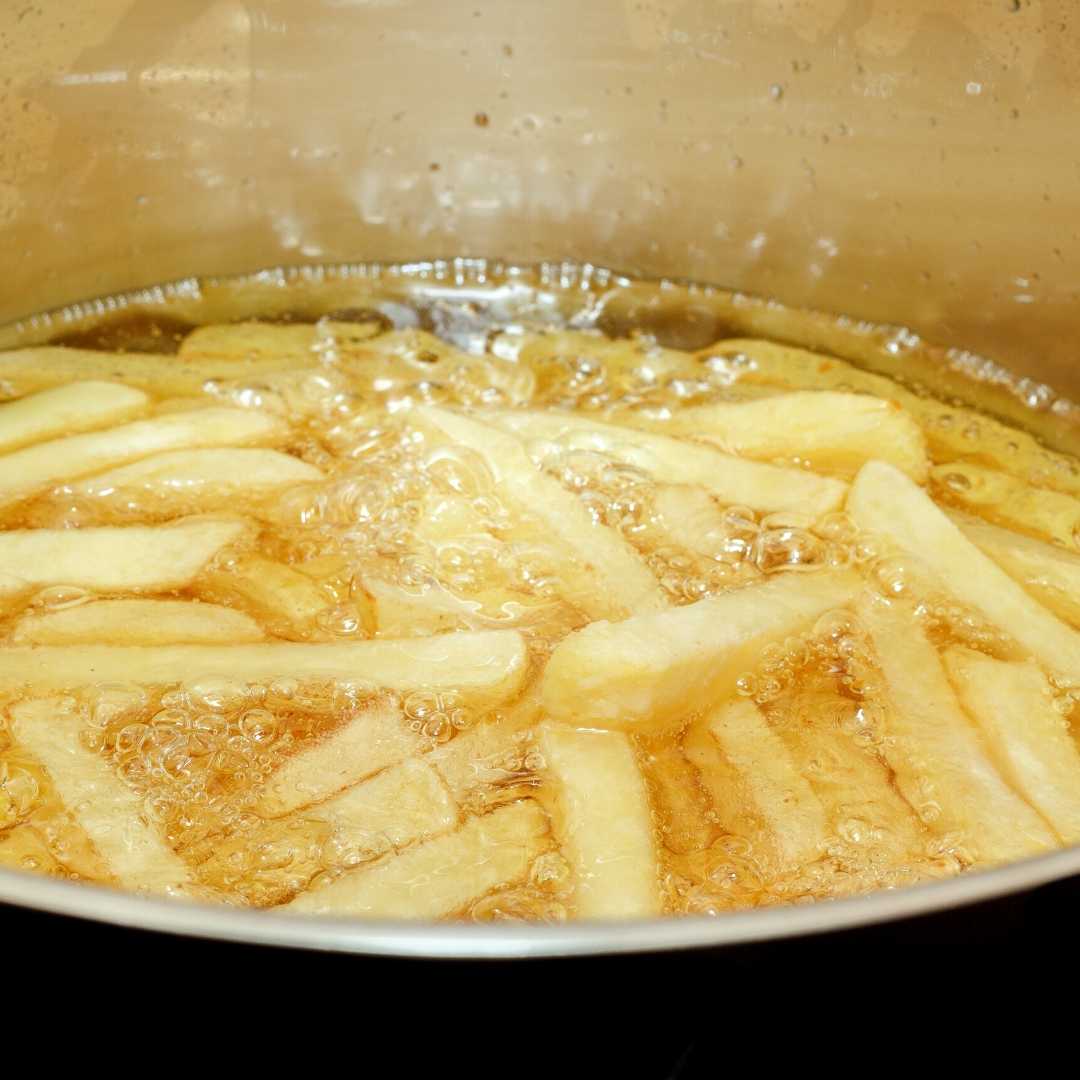
If you do not have proper frying equipment, you can use a deep and heavy cooking pot, deep saucepan, stockpot, wok, or frying pan.
When frying at home and not that often, you might think that you can use your oil a lot longer than the restaurants. But unfortunately, that is not the case. Home frying could ruin your oil faster than frying at a restaurant.
The reason for that is the temperature and the heating arrangement. In a commercial electric restaurant deep fryer, the oil is not heated from the bottom up as you would do at home, heating the oil in the pot on the burner.
The heating element of the commercial deep fryer is actually placed in the middle, which creates a layer of cooler oil at the very bottom. As bits of food sink to the bottom of the fryer, they won’t burn as they would when using the pot on the burner.
Also, restaurant deep fryers are programmed to keep the optimum temperature, which helps the oil last longer.
When frying at home, most people don’t monitor the temperature and are likely to overheat and burn the oil, which causes it to break down a lot faster. To prevent this, clean your deep fryer as often as possible and use a thermometer to keep the oil from burning.
However, if you do fry food quite often, instead of using a pot or a pan, you would be better off getting a small fryer. That will give you better results, tastier food, and cleaner oil.
The fryer below is the one I got from Amazon; it does a really good job and has some great features. It comes with an immersed heating element that quickly recovers oil temperature. It comes with a basket and has a unique filtration system. Not only will the food that you cook be a lot better, but you will also save on oil, so you will probably recover the cost of a fryer quite quickly.
TAP ON IMAGE TO VIEW PRICE
How To Store Used Cooking Oil?
Follow these steps to store the used frying oil properly:
- Let the frying oil cool down until it reaches room temperature. It will take around 2 hours, so be patient!
- Remove all the remaining food parts with the fryer.
- Filtering the oil after every use is very important if you want to keep it for the next use. Many fryers have an automated filtering system used mostly by restaurants, but you can also do it manually at home.
- Pour the oil through a fine strainer or use a funnel with a coffee filter or cheesecloth.
- After filtering, put the oil in a sealable, airtight, and light-proof container; for example, you can use a metal container or a glass bottle.
- Store it in a cool, dark, and dry place for up to three months. The air in the storage area must be dry and free of odors or undesirable vapors. If it is quite warm where you live and you cannot find a cool storage place, you can also put the used oil in the fridge.
- Cooking oil should be stored under cool conditions, normally at temperatures between 57°F and 70ºF (14°C and 21ºC).
Below is an example of easy to use a container with a strainer in which to store your used cooking oil or fat.
TAP ON IMAGE TO VIEW PRICE
How To Clean Cooking Oil For Reuse?
If you want to deep fry food again using the same oil, you should remove all the random bits of food from it. If there are only a few pieces of debris floating around on the top, then just skim the oil and remove any pieces of fries, chickens, batter, or crumbs.
However, if there is too much debris at the bottom, then it is best to filter it. If you don’t have a fine strainer, you can use coffee filters or cheesecloth. After filtering, put the oil in an airtight container and keep it in a cool and dark place.
Can I Just Leave The Oil In My Deep Fryer?
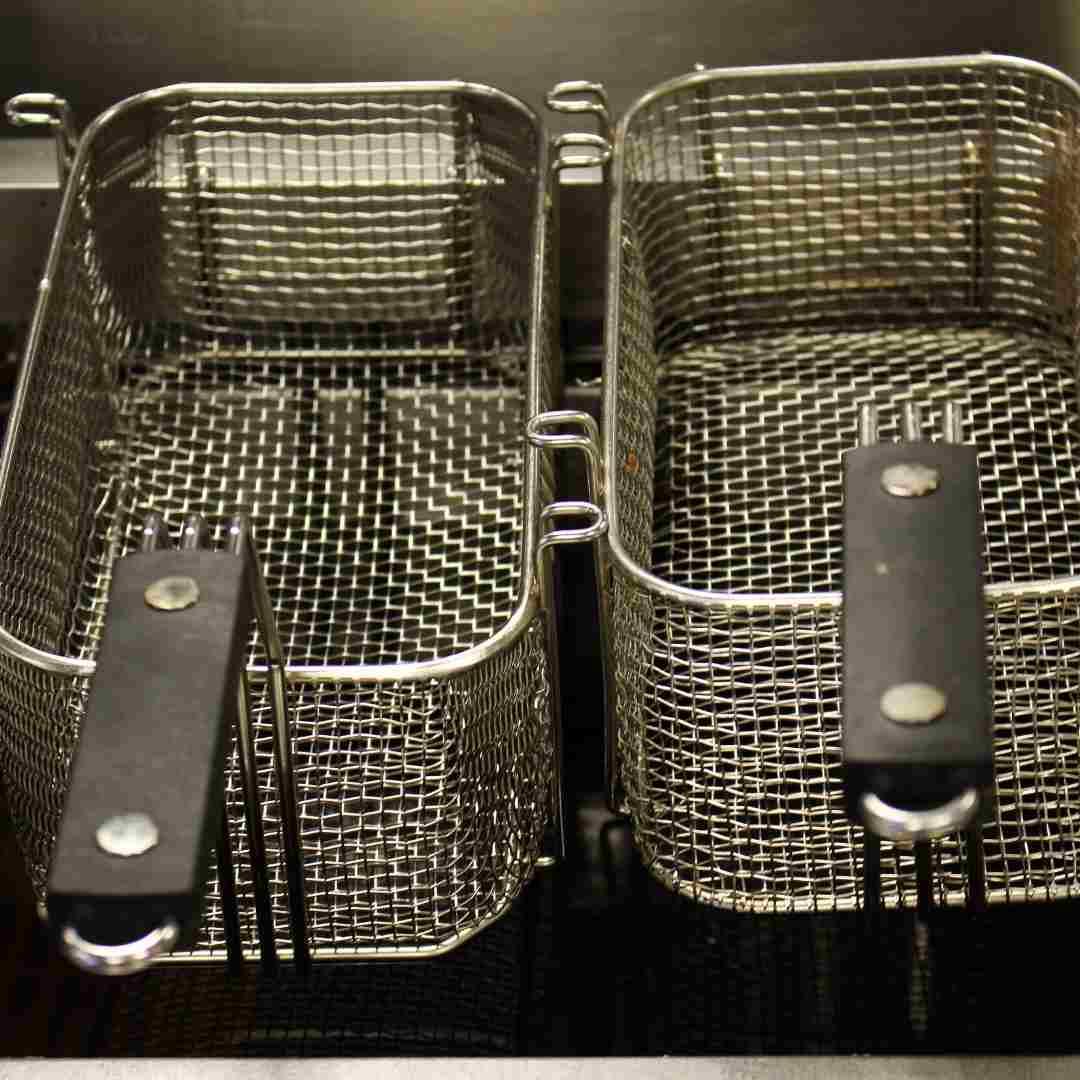
You can leave the oil in your fryer after use, but it is better to remove the oil from the fryer, filter the oil, and clean the fryer and ten but back. If you are not going to fry it for some time, then storing it separately in the container is best. If you do leave it in the fryer, then cover it well because air and light will damage the oil and won’t attract unwanted intruders, such as flies, insects, or rodents.
How To Properly Clean The Frying Equipment?
Before cleaning your fryer or frying pot, you should first check the cleaning instructions on the owner’s manual, but here are some general rules that you should follow:
- Before you start cleaning up, make sure the equipment is turned off and unplugged.
- If using a frying pan, take it off the heat.
- Make sure the fryer is completely cooled.
- Remove the oil from the pan or fryer and put it in the storage or recycling container.
- Pour very hot water and dish soap into the pan or fryer and brush it well. Use the cleanup rod if needed. After that, rinse well with clean water and let it dry.
- Don’t forget to clean the exterior of the equipment as well. If there is a lot of fat build-up and soap with water does not work, you can add a decreasing product. Let it sit for a few minutes, then rinse it off and dry with a clean cloth.
Once in a while, you should give your fryer a really good and thoroughly clean. That is called boil out, which means adding a special cleaning solution and water and then boiling the water to remove all hard, stuck grime and grease.
How To Dispose Of Used Cooking Oil?
The best way to dispose of used cooking oil or fat is to recycle it. If there is no such option where you live, you should pour the cooled oil into a sealable container and then throw it in the trash. You can use a metal coffee can, for example.
Avoid using glass containers because if they break, they will create a mess, and the glass might harm the garbage collectors. Personally, I keep a grease disposal container under my sink, and I find it pretty useful. It keeps my kitchen clean and free of used oil smell.
Also, this way, I protect the pipes in my house from clogging. When the bag is full, I seal it and recycle it or discard it safely in the garbage.
TAP ON IMAGE TO VIEW PRICE
Tips For Recycling?
I highly recommend recycling your used cooking oil because it is used to produce biodiesel fuel or soap. If you are unsure how to do it, check out these suggestions below.
- Check if there are recycle points in your area. Many cities have drop-off points for used oils.
- Ask the store that you bought the oil from. Many big supermarkets or commercial centers have big bins into which you can directly pour the used oil.
- Contact your local restaurants. Usually, they have large quantities of used oil and fat, and they might be a part of a recycling program. Check with them to see if they will accept your used oil.
- Check if there are waste disposal companies around you willing to pick up your used oil.
Can You Pour Cooking Oil Down The Drain?

No, you should never pour the oil down the kitchen sink or the toilet. The oil will cool with water in the drain, it will solidify, and this can cause serious blockage in your house pipes and the public sewage system. Many sewage stations have serious problems from oil and fat build-up in the pipes.
To Wrap Up
Now you are ready to use and handle your frying oil in a responsible, safe, and eco-friendly way.
And don’t worry if your food did not turn out perfect for the first time. It will take a few tries, some practice, and patience to get perfect crispy and golden food. Eventually, you will master the art of deep-frying.
How to fry food without oil? Here is the secret to fat-free and crispy frying. Read my latest article here >>>
